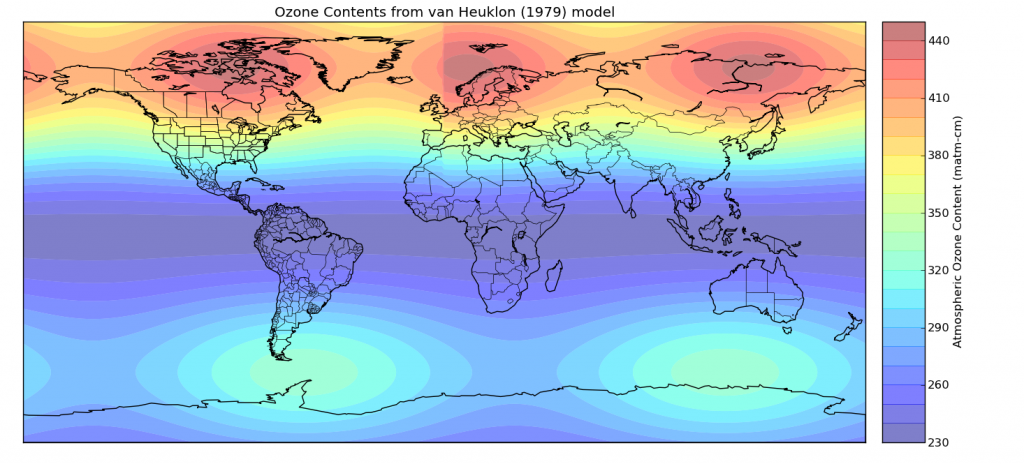van Heuklon Ozone model implementation in Python
As part of my PhD I wanted to use a simple model which would give me an estimation of the atmospheric ozone amount given a location and time of year. A simple model to do this was created by van Heuklon in 1979, and was described in a delightfully simple paper (unfortunately not freely available online, but see the reference below) using a simple formula. The map below shows the modelled ozone amounts across the world for 15th April (click to enlarge):
The formula was built up from a baseline ozone amount (235 matm-cm) which then has various components added to it, some of which varied based upon latitude, longitude or time of year. The model isn’t intended to be accurate or high-resolution, but provides me with a rough estimate of the ozone amount at a given location at a given time. Accurate measurements of ozone amounts are available from satellites, but I would need to get data from many different times of year to be able to take into account the seasonal variation in ozone amounts, and the satellite data would take up a lot of space – hence using this simple model.
The code for this model is available on Github and has two implementations: get_ozone_conc and old_get_ozone_conc. The latter uses standard Python code with if statements to set the different values in the formula depending on the input latitudes and longitudes, which means it can only process one latitude/longitude combination at once. get_ozone_conc, on the other hand, uses somewhat more complicated numpy code which allows you to pass it arrays of latitudes and longitudes and it will return an array of results. This is what was used to produce the map above – the code for which is also in the repository.
This code was created for use as part of my PhD, but has been released into the public domain (as CC0) in case anyone else finds it useful.
Also, for those of you using Py6S (my Python interface to the 6S atmospheric Radiative Transfer Model), I’m sure you will be pleased to know that this model will shortly be integrated into Py6S to allow you to easily specify ozone amounts using it.
References:
van Heuklon, T. K. (1979). Estimating atmospheric ozone for solar radiation models. Solar Energy, 22(1), 63-68
If you found this post useful, please consider buying me a coffee.
This post originally appeared on Robin's Blog.
Categorised as: Academic, GIS, Py6S, Python, Remote Sensing

[…] unpublicised code’ posts, but that would be stretching the title a bit, as I have previously blogged about my implementation of the van Heuklon (1979) ozone […]
[…] already written a post about my implementation of the van Heuklon Ozone model – and this year I turned it into a […]
[…] VanHOzone (my, very simple, implementation of the van Heuklon ozone model) has been used in a MSc thesis […]
[…] VanHOzone (my, very simple, implementation of the van Heuklon ozone model) has been used in a MSc thesis […]